Barclays Talent Management Strategy: Analysis and Recommendations
VerifiedAdded on 2023/01/13
|12
|3793
|74
Report
AI Summary
This report provides a comprehensive analysis of Barclays' talent management strategy, encompassing its business and HR strategies, regulatory factors impacting HRM practices, and relevant environmental influences. It delves into Barclays' approach to attracting, developing, and retaining talented employees through people management, democratized structure, competency-based pay, and strategic recruitment and selection processes. The report further examines performance management, reward systems, training and development initiatives, and equality and diversity practices within the organization. It also identifies key regulatory factors, such as equality legislation, minimum wages act, and health and safety regulations, and environmental factors, including economic, technological, and cultural aspects, that shape Barclays' HRM practices. Finally, the report includes a detailed analysis of core positions, such as bank tellers, outlining desired job roles, skills, behaviors, and knowledge essential for effective performance, and offers strategic recommendations for enhancing Barclays' talent management approach.
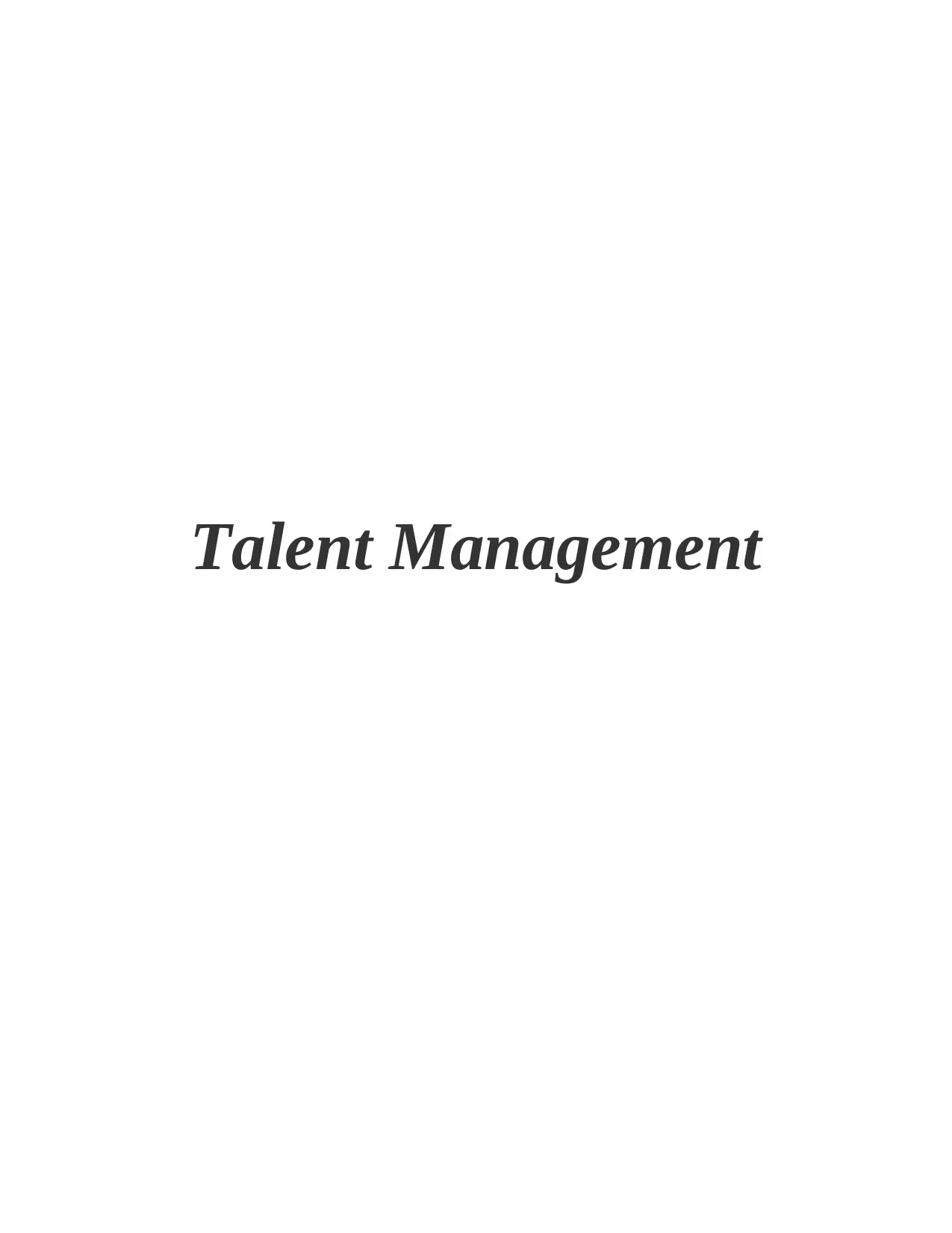
Talent Management
Paraphrase This Document
Need a fresh take? Get an instant paraphrase of this document with our AI Paraphraser

Table of Contents
INTRODUCTION...........................................................................................................................1
PART 1............................................................................................................................................1
Analyse the current talent management strategy of Barclays. For this, the following
information is needed:.................................................................................................................1
PART 2............................................................................................................................................4
Analysing the relevant regulatory factors which impact on organisation and HRM practices...4
PART 3............................................................................................................................................4
Identifying environmental factors which might impact on HRM practices in Barclays.............4
PART 4............................................................................................................................................5
Analysing the current core positions that is being advertised in an organisation. Also, develop
detail information about the desired job roles, skills, behaviours, attitudes, knowledge which
is consider a key to effective performance in this role. Such includes:......................................5
PART 5............................................................................................................................................8
Recommendations.......................................................................................................................8
CONCLUSION................................................................................................................................9
REFERENCES..............................................................................................................................10
INTRODUCTION...........................................................................................................................1
PART 1............................................................................................................................................1
Analyse the current talent management strategy of Barclays. For this, the following
information is needed:.................................................................................................................1
PART 2............................................................................................................................................4
Analysing the relevant regulatory factors which impact on organisation and HRM practices...4
PART 3............................................................................................................................................4
Identifying environmental factors which might impact on HRM practices in Barclays.............4
PART 4............................................................................................................................................5
Analysing the current core positions that is being advertised in an organisation. Also, develop
detail information about the desired job roles, skills, behaviours, attitudes, knowledge which
is consider a key to effective performance in this role. Such includes:......................................5
PART 5............................................................................................................................................8
Recommendations.......................................................................................................................8
CONCLUSION................................................................................................................................9
REFERENCES..............................................................................................................................10
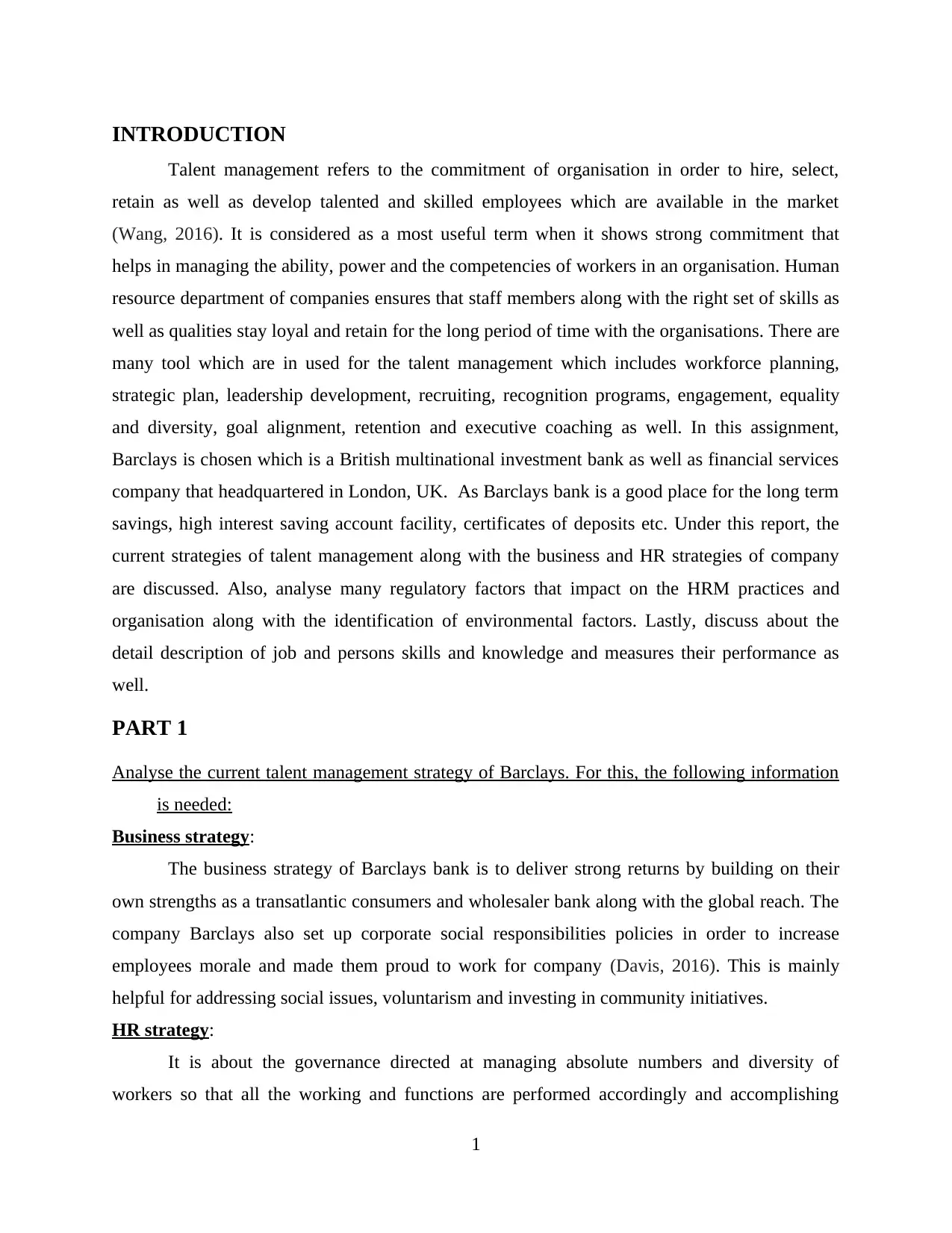
INTRODUCTION
Talent management refers to the commitment of organisation in order to hire, select,
retain as well as develop talented and skilled employees which are available in the market
(Wang, 2016). It is considered as a most useful term when it shows strong commitment that
helps in managing the ability, power and the competencies of workers in an organisation. Human
resource department of companies ensures that staff members along with the right set of skills as
well as qualities stay loyal and retain for the long period of time with the organisations. There are
many tool which are in used for the talent management which includes workforce planning,
strategic plan, leadership development, recruiting, recognition programs, engagement, equality
and diversity, goal alignment, retention and executive coaching as well. In this assignment,
Barclays is chosen which is a British multinational investment bank as well as financial services
company that headquartered in London, UK. As Barclays bank is a good place for the long term
savings, high interest saving account facility, certificates of deposits etc. Under this report, the
current strategies of talent management along with the business and HR strategies of company
are discussed. Also, analyse many regulatory factors that impact on the HRM practices and
organisation along with the identification of environmental factors. Lastly, discuss about the
detail description of job and persons skills and knowledge and measures their performance as
well.
PART 1
Analyse the current talent management strategy of Barclays. For this, the following information
is needed:
Business strategy:
The business strategy of Barclays bank is to deliver strong returns by building on their
own strengths as a transatlantic consumers and wholesaler bank along with the global reach. The
company Barclays also set up corporate social responsibilities policies in order to increase
employees morale and made them proud to work for company (Davis, 2016). This is mainly
helpful for addressing social issues, voluntarism and investing in community initiatives.
HR strategy:
It is about the governance directed at managing absolute numbers and diversity of
workers so that all the working and functions are performed accordingly and accomplishing
1
Talent management refers to the commitment of organisation in order to hire, select,
retain as well as develop talented and skilled employees which are available in the market
(Wang, 2016). It is considered as a most useful term when it shows strong commitment that
helps in managing the ability, power and the competencies of workers in an organisation. Human
resource department of companies ensures that staff members along with the right set of skills as
well as qualities stay loyal and retain for the long period of time with the organisations. There are
many tool which are in used for the talent management which includes workforce planning,
strategic plan, leadership development, recruiting, recognition programs, engagement, equality
and diversity, goal alignment, retention and executive coaching as well. In this assignment,
Barclays is chosen which is a British multinational investment bank as well as financial services
company that headquartered in London, UK. As Barclays bank is a good place for the long term
savings, high interest saving account facility, certificates of deposits etc. Under this report, the
current strategies of talent management along with the business and HR strategies of company
are discussed. Also, analyse many regulatory factors that impact on the HRM practices and
organisation along with the identification of environmental factors. Lastly, discuss about the
detail description of job and persons skills and knowledge and measures their performance as
well.
PART 1
Analyse the current talent management strategy of Barclays. For this, the following information
is needed:
Business strategy:
The business strategy of Barclays bank is to deliver strong returns by building on their
own strengths as a transatlantic consumers and wholesaler bank along with the global reach. The
company Barclays also set up corporate social responsibilities policies in order to increase
employees morale and made them proud to work for company (Davis, 2016). This is mainly
helpful for addressing social issues, voluntarism and investing in community initiatives.
HR strategy:
It is about the governance directed at managing absolute numbers and diversity of
workers so that all the working and functions are performed accordingly and accomplishing
1
⊘ This is a preview!⊘
Do you want full access?
Subscribe today to unlock all pages.

Trusted by 1+ million students worldwide
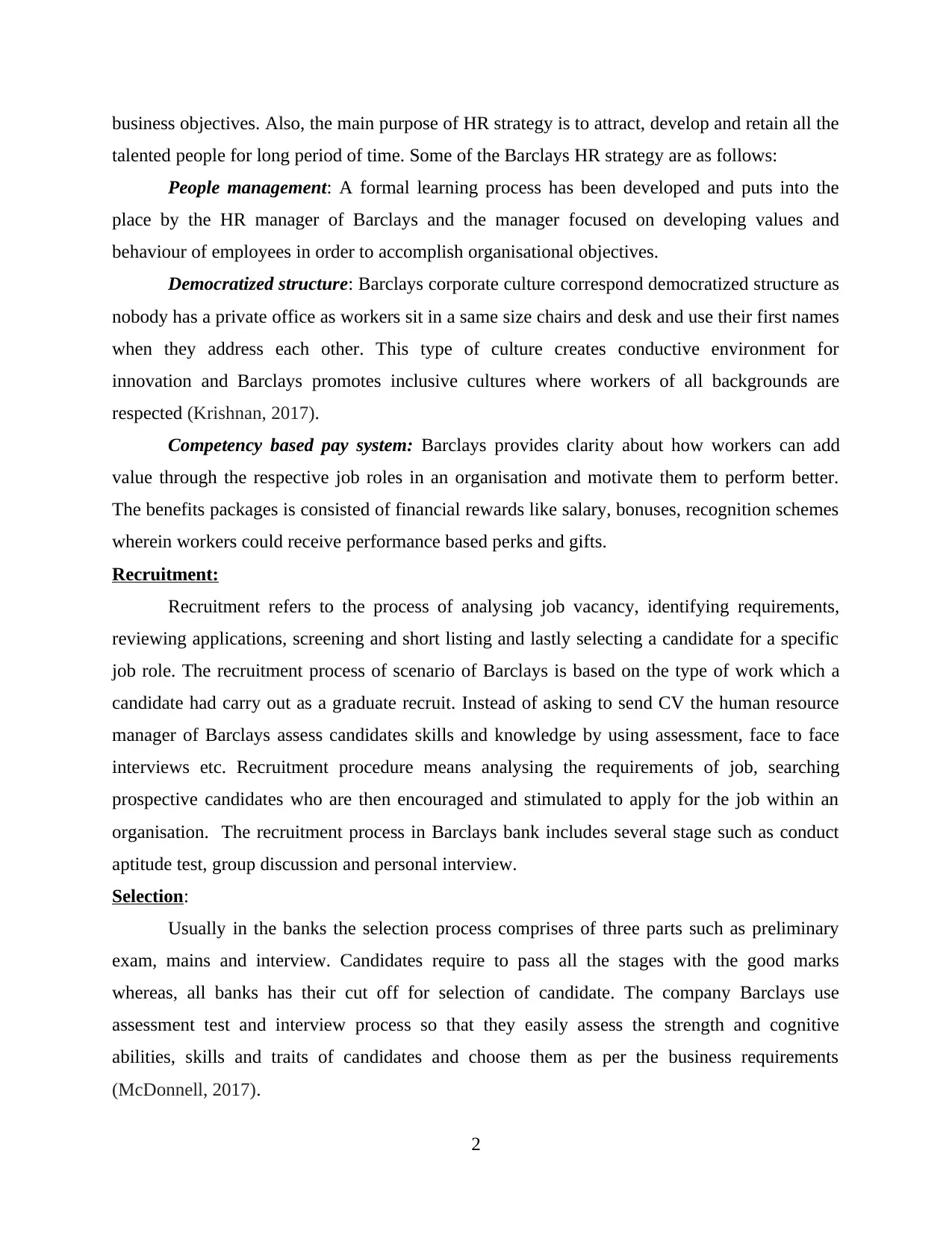
business objectives. Also, the main purpose of HR strategy is to attract, develop and retain all the
talented people for long period of time. Some of the Barclays HR strategy are as follows:
People management: A formal learning process has been developed and puts into the
place by the HR manager of Barclays and the manager focused on developing values and
behaviour of employees in order to accomplish organisational objectives.
Democratized structure: Barclays corporate culture correspond democratized structure as
nobody has a private office as workers sit in a same size chairs and desk and use their first names
when they address each other. This type of culture creates conductive environment for
innovation and Barclays promotes inclusive cultures where workers of all backgrounds are
respected (Krishnan, 2017).
Competency based pay system: Barclays provides clarity about how workers can add
value through the respective job roles in an organisation and motivate them to perform better.
The benefits packages is consisted of financial rewards like salary, bonuses, recognition schemes
wherein workers could receive performance based perks and gifts.
Recruitment:
Recruitment refers to the process of analysing job vacancy, identifying requirements,
reviewing applications, screening and short listing and lastly selecting a candidate for a specific
job role. The recruitment process of scenario of Barclays is based on the type of work which a
candidate had carry out as a graduate recruit. Instead of asking to send CV the human resource
manager of Barclays assess candidates skills and knowledge by using assessment, face to face
interviews etc. Recruitment procedure means analysing the requirements of job, searching
prospective candidates who are then encouraged and stimulated to apply for the job within an
organisation. The recruitment process in Barclays bank includes several stage such as conduct
aptitude test, group discussion and personal interview.
Selection:
Usually in the banks the selection process comprises of three parts such as preliminary
exam, mains and interview. Candidates require to pass all the stages with the good marks
whereas, all banks has their cut off for selection of candidate. The company Barclays use
assessment test and interview process so that they easily assess the strength and cognitive
abilities, skills and traits of candidates and choose them as per the business requirements
(McDonnell, 2017).
2
talented people for long period of time. Some of the Barclays HR strategy are as follows:
People management: A formal learning process has been developed and puts into the
place by the HR manager of Barclays and the manager focused on developing values and
behaviour of employees in order to accomplish organisational objectives.
Democratized structure: Barclays corporate culture correspond democratized structure as
nobody has a private office as workers sit in a same size chairs and desk and use their first names
when they address each other. This type of culture creates conductive environment for
innovation and Barclays promotes inclusive cultures where workers of all backgrounds are
respected (Krishnan, 2017).
Competency based pay system: Barclays provides clarity about how workers can add
value through the respective job roles in an organisation and motivate them to perform better.
The benefits packages is consisted of financial rewards like salary, bonuses, recognition schemes
wherein workers could receive performance based perks and gifts.
Recruitment:
Recruitment refers to the process of analysing job vacancy, identifying requirements,
reviewing applications, screening and short listing and lastly selecting a candidate for a specific
job role. The recruitment process of scenario of Barclays is based on the type of work which a
candidate had carry out as a graduate recruit. Instead of asking to send CV the human resource
manager of Barclays assess candidates skills and knowledge by using assessment, face to face
interviews etc. Recruitment procedure means analysing the requirements of job, searching
prospective candidates who are then encouraged and stimulated to apply for the job within an
organisation. The recruitment process in Barclays bank includes several stage such as conduct
aptitude test, group discussion and personal interview.
Selection:
Usually in the banks the selection process comprises of three parts such as preliminary
exam, mains and interview. Candidates require to pass all the stages with the good marks
whereas, all banks has their cut off for selection of candidate. The company Barclays use
assessment test and interview process so that they easily assess the strength and cognitive
abilities, skills and traits of candidates and choose them as per the business requirements
(McDonnell, 2017).
2
Paraphrase This Document
Need a fresh take? Get an instant paraphrase of this document with our AI Paraphraser
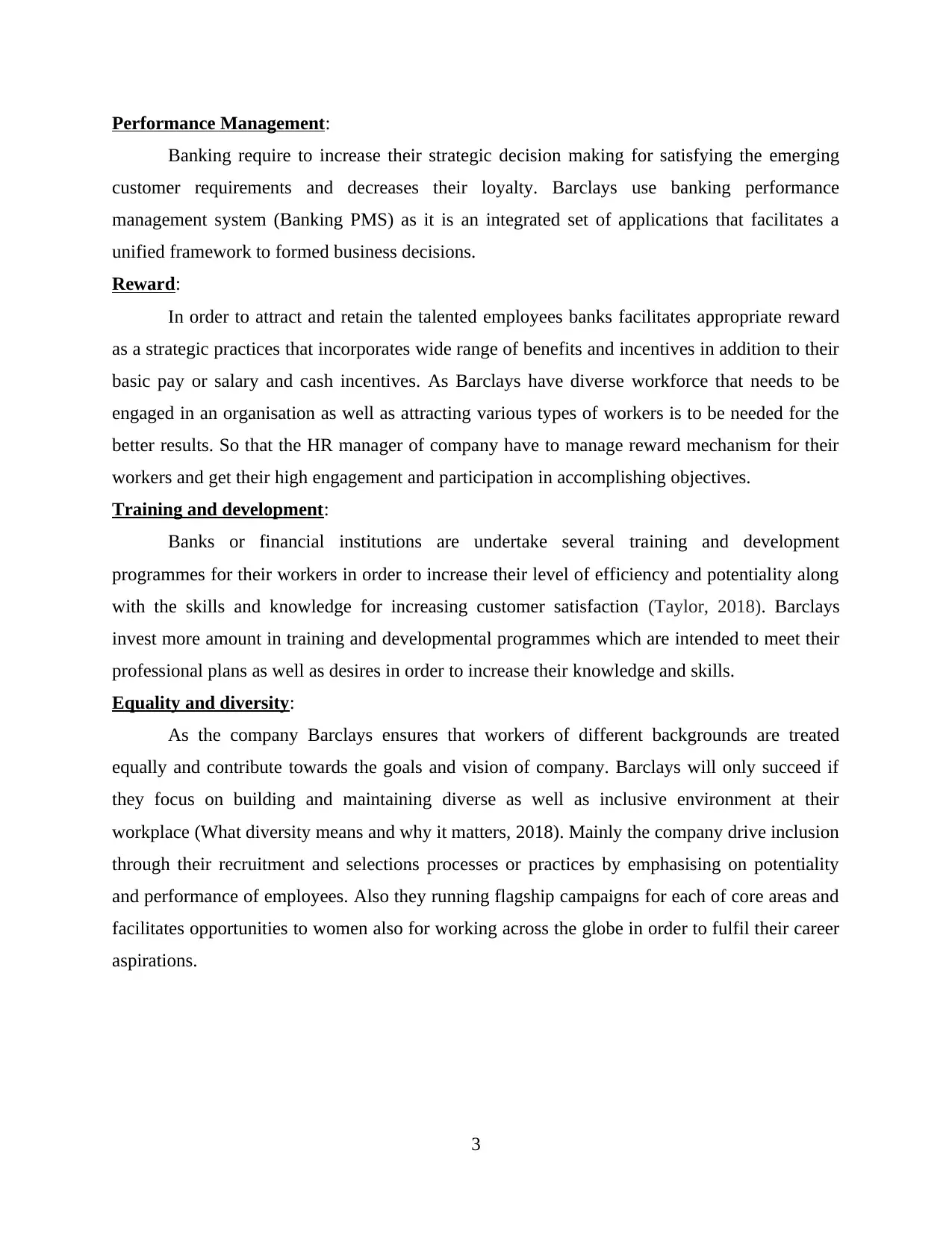
Performance Management:
Banking require to increase their strategic decision making for satisfying the emerging
customer requirements and decreases their loyalty. Barclays use banking performance
management system (Banking PMS) as it is an integrated set of applications that facilitates a
unified framework to formed business decisions.
Reward:
In order to attract and retain the talented employees banks facilitates appropriate reward
as a strategic practices that incorporates wide range of benefits and incentives in addition to their
basic pay or salary and cash incentives. As Barclays have diverse workforce that needs to be
engaged in an organisation as well as attracting various types of workers is to be needed for the
better results. So that the HR manager of company have to manage reward mechanism for their
workers and get their high engagement and participation in accomplishing objectives.
Training and development:
Banks or financial institutions are undertake several training and development
programmes for their workers in order to increase their level of efficiency and potentiality along
with the skills and knowledge for increasing customer satisfaction (Taylor, 2018). Barclays
invest more amount in training and developmental programmes which are intended to meet their
professional plans as well as desires in order to increase their knowledge and skills.
Equality and diversity:
As the company Barclays ensures that workers of different backgrounds are treated
equally and contribute towards the goals and vision of company. Barclays will only succeed if
they focus on building and maintaining diverse as well as inclusive environment at their
workplace (What diversity means and why it matters, 2018). Mainly the company drive inclusion
through their recruitment and selections processes or practices by emphasising on potentiality
and performance of employees. Also they running flagship campaigns for each of core areas and
facilitates opportunities to women also for working across the globe in order to fulfil their career
aspirations.
3
Banking require to increase their strategic decision making for satisfying the emerging
customer requirements and decreases their loyalty. Barclays use banking performance
management system (Banking PMS) as it is an integrated set of applications that facilitates a
unified framework to formed business decisions.
Reward:
In order to attract and retain the talented employees banks facilitates appropriate reward
as a strategic practices that incorporates wide range of benefits and incentives in addition to their
basic pay or salary and cash incentives. As Barclays have diverse workforce that needs to be
engaged in an organisation as well as attracting various types of workers is to be needed for the
better results. So that the HR manager of company have to manage reward mechanism for their
workers and get their high engagement and participation in accomplishing objectives.
Training and development:
Banks or financial institutions are undertake several training and development
programmes for their workers in order to increase their level of efficiency and potentiality along
with the skills and knowledge for increasing customer satisfaction (Taylor, 2018). Barclays
invest more amount in training and developmental programmes which are intended to meet their
professional plans as well as desires in order to increase their knowledge and skills.
Equality and diversity:
As the company Barclays ensures that workers of different backgrounds are treated
equally and contribute towards the goals and vision of company. Barclays will only succeed if
they focus on building and maintaining diverse as well as inclusive environment at their
workplace (What diversity means and why it matters, 2018). Mainly the company drive inclusion
through their recruitment and selections processes or practices by emphasising on potentiality
and performance of employees. Also they running flagship campaigns for each of core areas and
facilitates opportunities to women also for working across the globe in order to fulfil their career
aspirations.
3
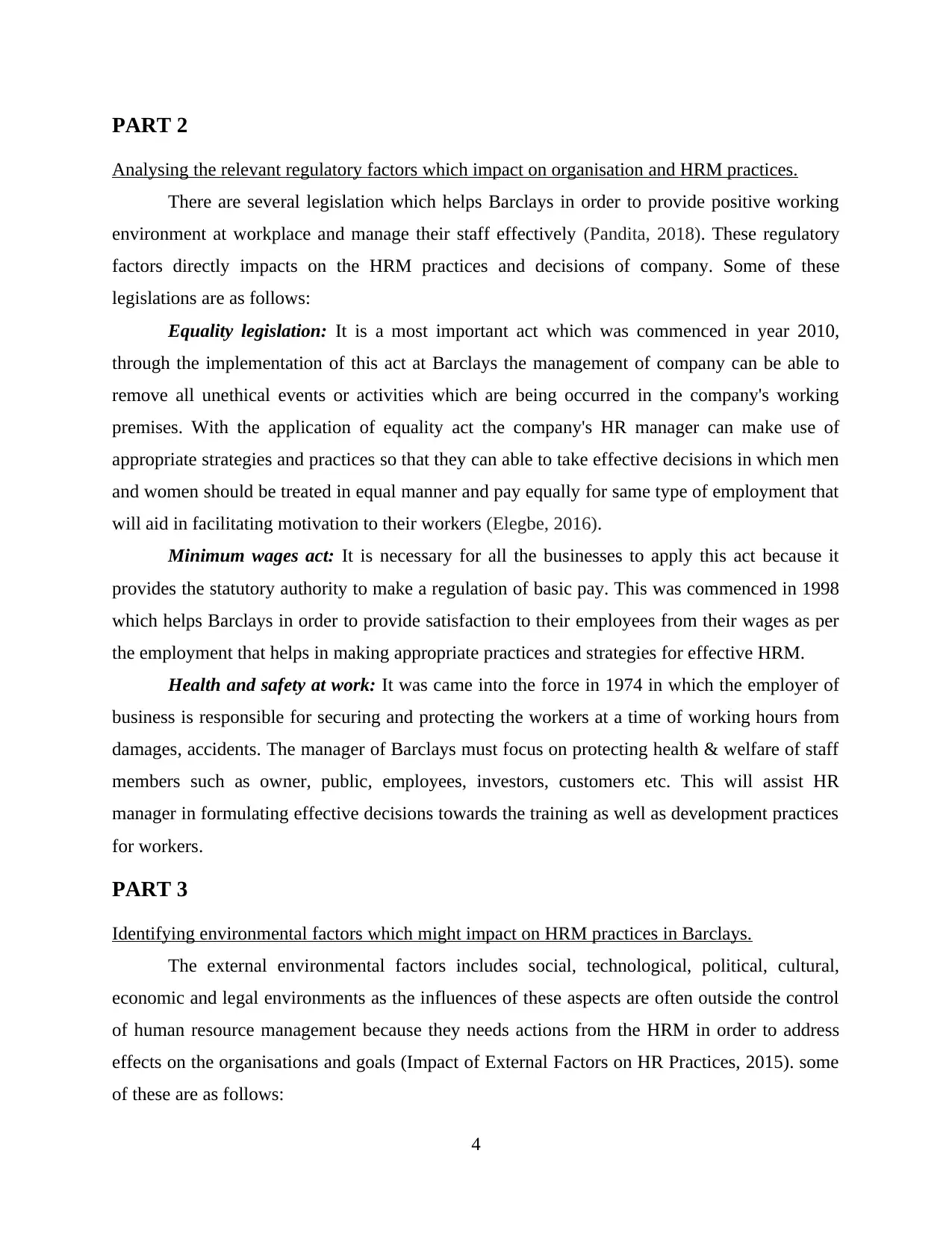
PART 2
Analysing the relevant regulatory factors which impact on organisation and HRM practices.
There are several legislation which helps Barclays in order to provide positive working
environment at workplace and manage their staff effectively (Pandita, 2018). These regulatory
factors directly impacts on the HRM practices and decisions of company. Some of these
legislations are as follows:
Equality legislation: It is a most important act which was commenced in year 2010,
through the implementation of this act at Barclays the management of company can be able to
remove all unethical events or activities which are being occurred in the company's working
premises. With the application of equality act the company's HR manager can make use of
appropriate strategies and practices so that they can able to take effective decisions in which men
and women should be treated in equal manner and pay equally for same type of employment that
will aid in facilitating motivation to their workers (Elegbe, 2016).
Minimum wages act: It is necessary for all the businesses to apply this act because it
provides the statutory authority to make a regulation of basic pay. This was commenced in 1998
which helps Barclays in order to provide satisfaction to their employees from their wages as per
the employment that helps in making appropriate practices and strategies for effective HRM.
Health and safety at work: It was came into the force in 1974 in which the employer of
business is responsible for securing and protecting the workers at a time of working hours from
damages, accidents. The manager of Barclays must focus on protecting health & welfare of staff
members such as owner, public, employees, investors, customers etc. This will assist HR
manager in formulating effective decisions towards the training as well as development practices
for workers.
PART 3
Identifying environmental factors which might impact on HRM practices in Barclays.
The external environmental factors includes social, technological, political, cultural,
economic and legal environments as the influences of these aspects are often outside the control
of human resource management because they needs actions from the HRM in order to address
effects on the organisations and goals (Impact of External Factors on HR Practices, 2015). some
of these are as follows:
4
Analysing the relevant regulatory factors which impact on organisation and HRM practices.
There are several legislation which helps Barclays in order to provide positive working
environment at workplace and manage their staff effectively (Pandita, 2018). These regulatory
factors directly impacts on the HRM practices and decisions of company. Some of these
legislations are as follows:
Equality legislation: It is a most important act which was commenced in year 2010,
through the implementation of this act at Barclays the management of company can be able to
remove all unethical events or activities which are being occurred in the company's working
premises. With the application of equality act the company's HR manager can make use of
appropriate strategies and practices so that they can able to take effective decisions in which men
and women should be treated in equal manner and pay equally for same type of employment that
will aid in facilitating motivation to their workers (Elegbe, 2016).
Minimum wages act: It is necessary for all the businesses to apply this act because it
provides the statutory authority to make a regulation of basic pay. This was commenced in 1998
which helps Barclays in order to provide satisfaction to their employees from their wages as per
the employment that helps in making appropriate practices and strategies for effective HRM.
Health and safety at work: It was came into the force in 1974 in which the employer of
business is responsible for securing and protecting the workers at a time of working hours from
damages, accidents. The manager of Barclays must focus on protecting health & welfare of staff
members such as owner, public, employees, investors, customers etc. This will assist HR
manager in formulating effective decisions towards the training as well as development practices
for workers.
PART 3
Identifying environmental factors which might impact on HRM practices in Barclays.
The external environmental factors includes social, technological, political, cultural,
economic and legal environments as the influences of these aspects are often outside the control
of human resource management because they needs actions from the HRM in order to address
effects on the organisations and goals (Impact of External Factors on HR Practices, 2015). some
of these are as follows:
4
⊘ This is a preview!⊘
Do you want full access?
Subscribe today to unlock all pages.

Trusted by 1+ million students worldwide

Economic factors: It is considered as a one of the biggest factor that have altered HRM
practices directly or indirectly. As economic condition is related to the labour market and supply
that impact on the recruitment and selection process of Barclays. Whereas in labour market,
decrease in supply of skilled and talented labour shapes the company's training and development
strategies.
Technological factors: The technological advancement positively impacts on the HR
practices and functions as it helps in managing activities effectively and efficiently. With the
help of technologies the manager of Barclays is able to manage the online recruitment process
and hire employee call for application through the advertisements (Tatoglu, 2016).
Cultural factors: It is very complex to manage for the HR manager of Barclays to
manage the culture of company. In the Barclays people are hired from different cultures that
creates mismanagement and diversity at workplace which can cause a big damage for the
business.
PART 4
Analysing the current core positions that is being advertised in an organisation. Also, develop
detail information about the desired job roles, skills, behaviours, attitudes, knowledge
which is consider a key to effective performance in this role. Such includes:
The Job description:
It is an internal document which contains the essential requirements along with the job
roles and responsibilities that defines where the job fits in the company's hierarchy which helps
company to grow (Collings, 2018). The job description of Barclays is considered as follows:
Job Description
Job Details
Position : Bank Teller
Company : Barclays Bank
Job purpose
Applicants are invited for handling customer financial transactions such as withdrawals, money
orders, deposits, checking, transfer etc. In addition, Bank Teller is also responsible for
answering calls, counting cash, managing deposits of ATM, filling deposits etc. at the end of a
day.
5
practices directly or indirectly. As economic condition is related to the labour market and supply
that impact on the recruitment and selection process of Barclays. Whereas in labour market,
decrease in supply of skilled and talented labour shapes the company's training and development
strategies.
Technological factors: The technological advancement positively impacts on the HR
practices and functions as it helps in managing activities effectively and efficiently. With the
help of technologies the manager of Barclays is able to manage the online recruitment process
and hire employee call for application through the advertisements (Tatoglu, 2016).
Cultural factors: It is very complex to manage for the HR manager of Barclays to
manage the culture of company. In the Barclays people are hired from different cultures that
creates mismanagement and diversity at workplace which can cause a big damage for the
business.
PART 4
Analysing the current core positions that is being advertised in an organisation. Also, develop
detail information about the desired job roles, skills, behaviours, attitudes, knowledge
which is consider a key to effective performance in this role. Such includes:
The Job description:
It is an internal document which contains the essential requirements along with the job
roles and responsibilities that defines where the job fits in the company's hierarchy which helps
company to grow (Collings, 2018). The job description of Barclays is considered as follows:
Job Description
Job Details
Position : Bank Teller
Company : Barclays Bank
Job purpose
Applicants are invited for handling customer financial transactions such as withdrawals, money
orders, deposits, checking, transfer etc. In addition, Bank Teller is also responsible for
answering calls, counting cash, managing deposits of ATM, filling deposits etc. at the end of a
day.
5
Paraphrase This Document
Need a fresh take? Get an instant paraphrase of this document with our AI Paraphraser
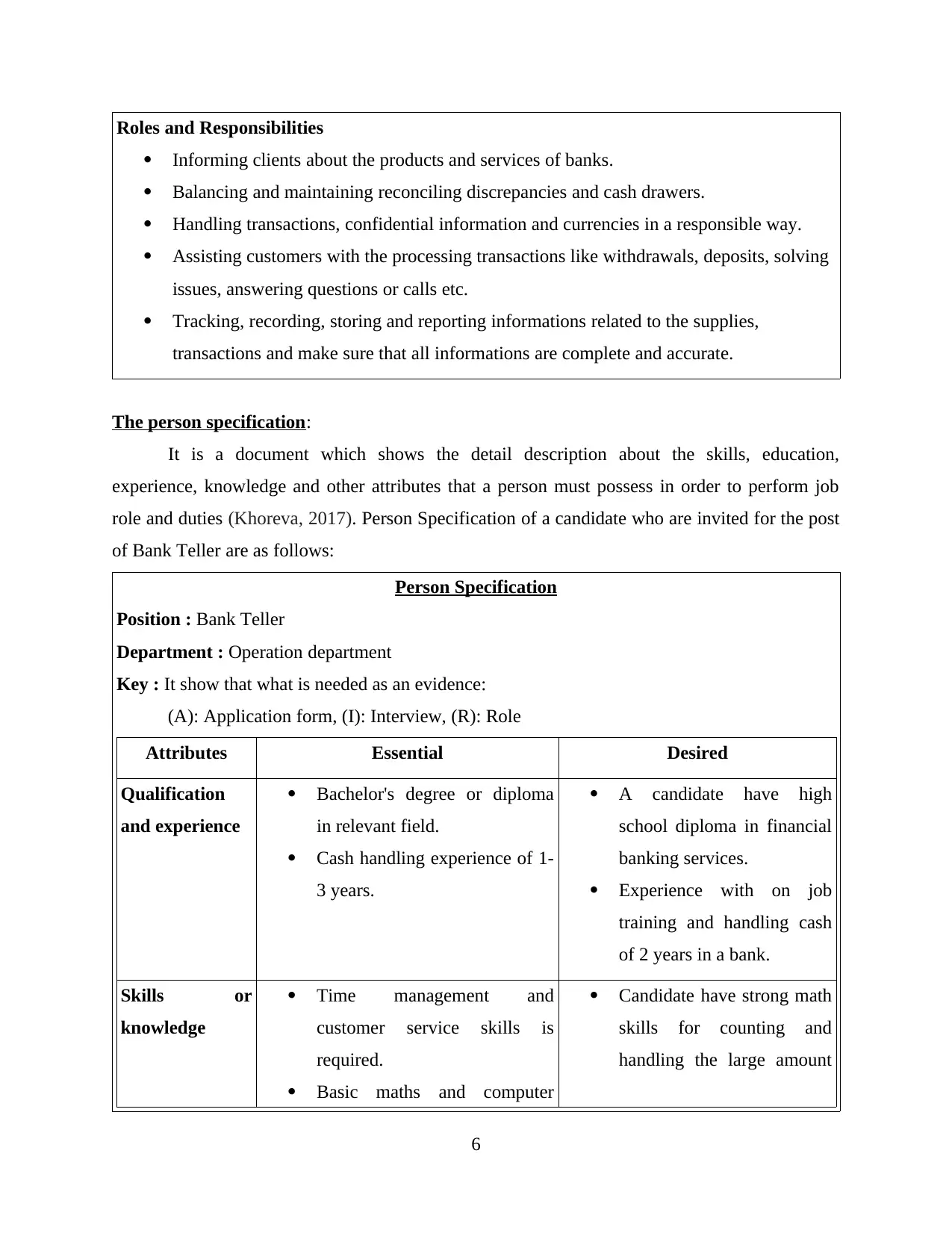
Roles and Responsibilities
Informing clients about the products and services of banks.
Balancing and maintaining reconciling discrepancies and cash drawers.
Handling transactions, confidential information and currencies in a responsible way.
Assisting customers with the processing transactions like withdrawals, deposits, solving
issues, answering questions or calls etc.
Tracking, recording, storing and reporting informations related to the supplies,
transactions and make sure that all informations are complete and accurate.
The person specification:
It is a document which shows the detail description about the skills, education,
experience, knowledge and other attributes that a person must possess in order to perform job
role and duties (Khoreva, 2017). Person Specification of a candidate who are invited for the post
of Bank Teller are as follows:
Person Specification
Position : Bank Teller
Department : Operation department
Key : It show that what is needed as an evidence:
(A): Application form, (I): Interview, (R): Role
Attributes Essential Desired
Qualification
and experience
Bachelor's degree or diploma
in relevant field.
Cash handling experience of 1-
3 years.
A candidate have high
school diploma in financial
banking services.
Experience with on job
training and handling cash
of 2 years in a bank.
Skills or
knowledge
Time management and
customer service skills is
required.
Basic maths and computer
Candidate have strong math
skills for counting and
handling the large amount
6
Informing clients about the products and services of banks.
Balancing and maintaining reconciling discrepancies and cash drawers.
Handling transactions, confidential information and currencies in a responsible way.
Assisting customers with the processing transactions like withdrawals, deposits, solving
issues, answering questions or calls etc.
Tracking, recording, storing and reporting informations related to the supplies,
transactions and make sure that all informations are complete and accurate.
The person specification:
It is a document which shows the detail description about the skills, education,
experience, knowledge and other attributes that a person must possess in order to perform job
role and duties (Khoreva, 2017). Person Specification of a candidate who are invited for the post
of Bank Teller are as follows:
Person Specification
Position : Bank Teller
Department : Operation department
Key : It show that what is needed as an evidence:
(A): Application form, (I): Interview, (R): Role
Attributes Essential Desired
Qualification
and experience
Bachelor's degree or diploma
in relevant field.
Cash handling experience of 1-
3 years.
A candidate have high
school diploma in financial
banking services.
Experience with on job
training and handling cash
of 2 years in a bank.
Skills or
knowledge
Time management and
customer service skills is
required.
Basic maths and computer
Candidate have strong math
skills for counting and
handling the large amount
6
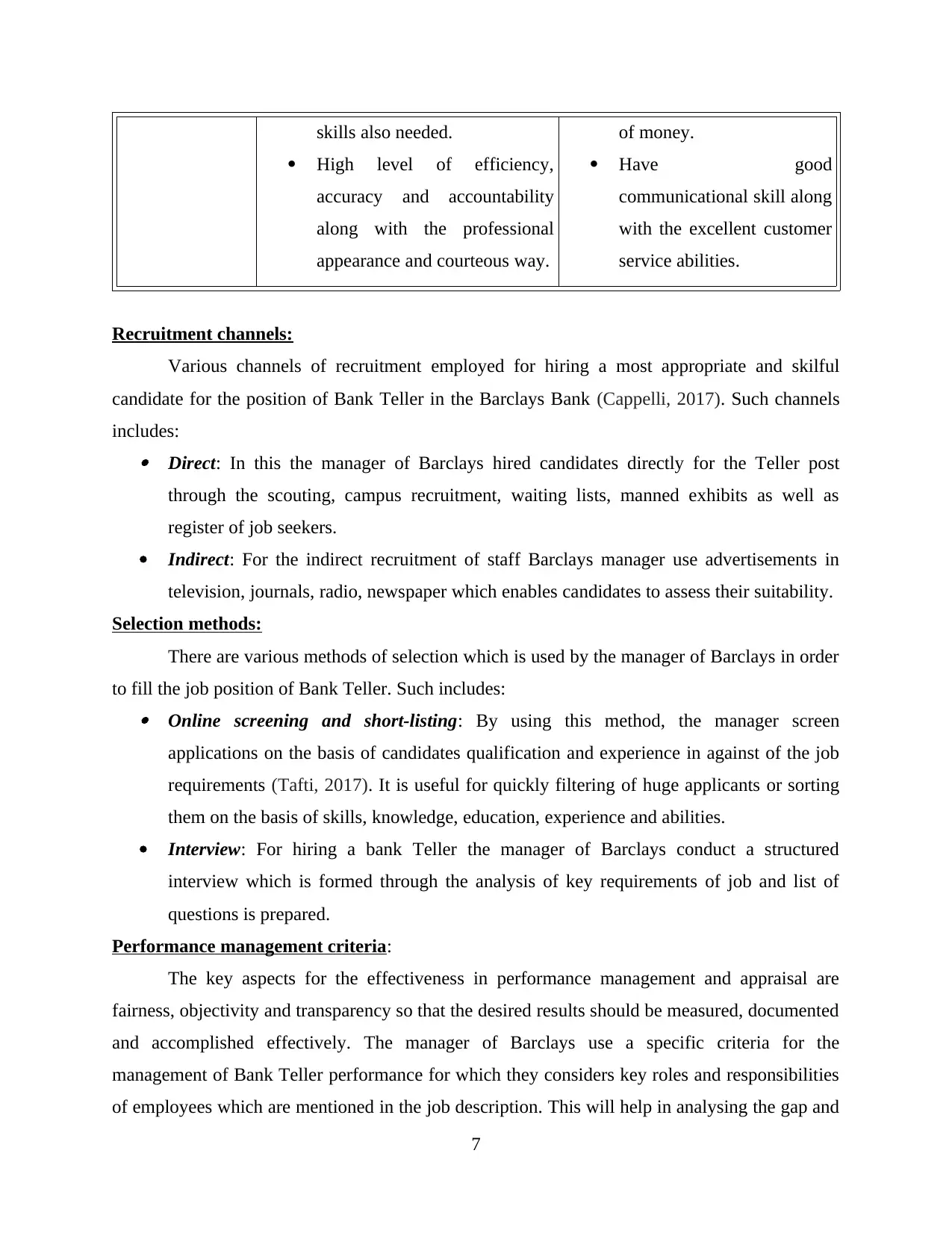
skills also needed.
High level of efficiency,
accuracy and accountability
along with the professional
appearance and courteous way.
of money.
Have good
communicational skill along
with the excellent customer
service abilities.
Recruitment channels:
Various channels of recruitment employed for hiring a most appropriate and skilful
candidate for the position of Bank Teller in the Barclays Bank (Cappelli, 2017). Such channels
includes: Direct: In this the manager of Barclays hired candidates directly for the Teller post
through the scouting, campus recruitment, waiting lists, manned exhibits as well as
register of job seekers.
Indirect: For the indirect recruitment of staff Barclays manager use advertisements in
television, journals, radio, newspaper which enables candidates to assess their suitability.
Selection methods:
There are various methods of selection which is used by the manager of Barclays in order
to fill the job position of Bank Teller. Such includes: Online screening and short-listing: By using this method, the manager screen
applications on the basis of candidates qualification and experience in against of the job
requirements (Tafti, 2017). It is useful for quickly filtering of huge applicants or sorting
them on the basis of skills, knowledge, education, experience and abilities.
Interview: For hiring a bank Teller the manager of Barclays conduct a structured
interview which is formed through the analysis of key requirements of job and list of
questions is prepared.
Performance management criteria:
The key aspects for the effectiveness in performance management and appraisal are
fairness, objectivity and transparency so that the desired results should be measured, documented
and accomplished effectively. The manager of Barclays use a specific criteria for the
management of Bank Teller performance for which they considers key roles and responsibilities
of employees which are mentioned in the job description. This will help in analysing the gap and
7
High level of efficiency,
accuracy and accountability
along with the professional
appearance and courteous way.
of money.
Have good
communicational skill along
with the excellent customer
service abilities.
Recruitment channels:
Various channels of recruitment employed for hiring a most appropriate and skilful
candidate for the position of Bank Teller in the Barclays Bank (Cappelli, 2017). Such channels
includes: Direct: In this the manager of Barclays hired candidates directly for the Teller post
through the scouting, campus recruitment, waiting lists, manned exhibits as well as
register of job seekers.
Indirect: For the indirect recruitment of staff Barclays manager use advertisements in
television, journals, radio, newspaper which enables candidates to assess their suitability.
Selection methods:
There are various methods of selection which is used by the manager of Barclays in order
to fill the job position of Bank Teller. Such includes: Online screening and short-listing: By using this method, the manager screen
applications on the basis of candidates qualification and experience in against of the job
requirements (Tafti, 2017). It is useful for quickly filtering of huge applicants or sorting
them on the basis of skills, knowledge, education, experience and abilities.
Interview: For hiring a bank Teller the manager of Barclays conduct a structured
interview which is formed through the analysis of key requirements of job and list of
questions is prepared.
Performance management criteria:
The key aspects for the effectiveness in performance management and appraisal are
fairness, objectivity and transparency so that the desired results should be measured, documented
and accomplished effectively. The manager of Barclays use a specific criteria for the
management of Bank Teller performance for which they considers key roles and responsibilities
of employees which are mentioned in the job description. This will help in analysing the gap and
7
⊘ This is a preview!⊘
Do you want full access?
Subscribe today to unlock all pages.

Trusted by 1+ million students worldwide
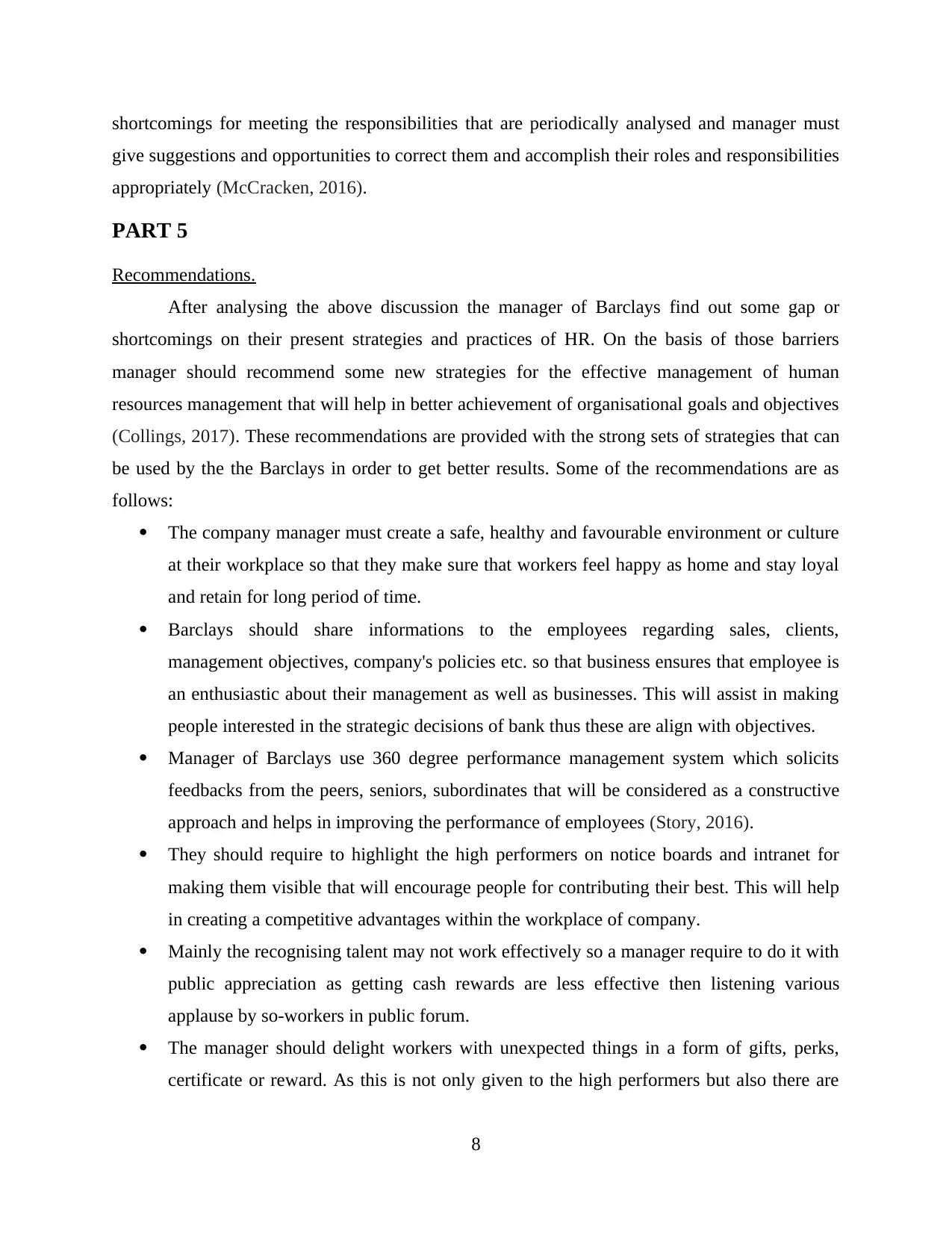
shortcomings for meeting the responsibilities that are periodically analysed and manager must
give suggestions and opportunities to correct them and accomplish their roles and responsibilities
appropriately (McCracken, 2016).
PART 5
Recommendations.
After analysing the above discussion the manager of Barclays find out some gap or
shortcomings on their present strategies and practices of HR. On the basis of those barriers
manager should recommend some new strategies for the effective management of human
resources management that will help in better achievement of organisational goals and objectives
(Collings, 2017). These recommendations are provided with the strong sets of strategies that can
be used by the the Barclays in order to get better results. Some of the recommendations are as
follows:
The company manager must create a safe, healthy and favourable environment or culture
at their workplace so that they make sure that workers feel happy as home and stay loyal
and retain for long period of time.
Barclays should share informations to the employees regarding sales, clients,
management objectives, company's policies etc. so that business ensures that employee is
an enthusiastic about their management as well as businesses. This will assist in making
people interested in the strategic decisions of bank thus these are align with objectives.
Manager of Barclays use 360 degree performance management system which solicits
feedbacks from the peers, seniors, subordinates that will be considered as a constructive
approach and helps in improving the performance of employees (Story, 2016).
They should require to highlight the high performers on notice boards and intranet for
making them visible that will encourage people for contributing their best. This will help
in creating a competitive advantages within the workplace of company.
Mainly the recognising talent may not work effectively so a manager require to do it with
public appreciation as getting cash rewards are less effective then listening various
applause by so-workers in public forum.
The manager should delight workers with unexpected things in a form of gifts, perks,
certificate or reward. As this is not only given to the high performers but also there are
8
give suggestions and opportunities to correct them and accomplish their roles and responsibilities
appropriately (McCracken, 2016).
PART 5
Recommendations.
After analysing the above discussion the manager of Barclays find out some gap or
shortcomings on their present strategies and practices of HR. On the basis of those barriers
manager should recommend some new strategies for the effective management of human
resources management that will help in better achievement of organisational goals and objectives
(Collings, 2017). These recommendations are provided with the strong sets of strategies that can
be used by the the Barclays in order to get better results. Some of the recommendations are as
follows:
The company manager must create a safe, healthy and favourable environment or culture
at their workplace so that they make sure that workers feel happy as home and stay loyal
and retain for long period of time.
Barclays should share informations to the employees regarding sales, clients,
management objectives, company's policies etc. so that business ensures that employee is
an enthusiastic about their management as well as businesses. This will assist in making
people interested in the strategic decisions of bank thus these are align with objectives.
Manager of Barclays use 360 degree performance management system which solicits
feedbacks from the peers, seniors, subordinates that will be considered as a constructive
approach and helps in improving the performance of employees (Story, 2016).
They should require to highlight the high performers on notice boards and intranet for
making them visible that will encourage people for contributing their best. This will help
in creating a competitive advantages within the workplace of company.
Mainly the recognising talent may not work effectively so a manager require to do it with
public appreciation as getting cash rewards are less effective then listening various
applause by so-workers in public forum.
The manager should delight workers with unexpected things in a form of gifts, perks,
certificate or reward. As this is not only given to the high performers but also there are
8
Paraphrase This Document
Need a fresh take? Get an instant paraphrase of this document with our AI Paraphraser
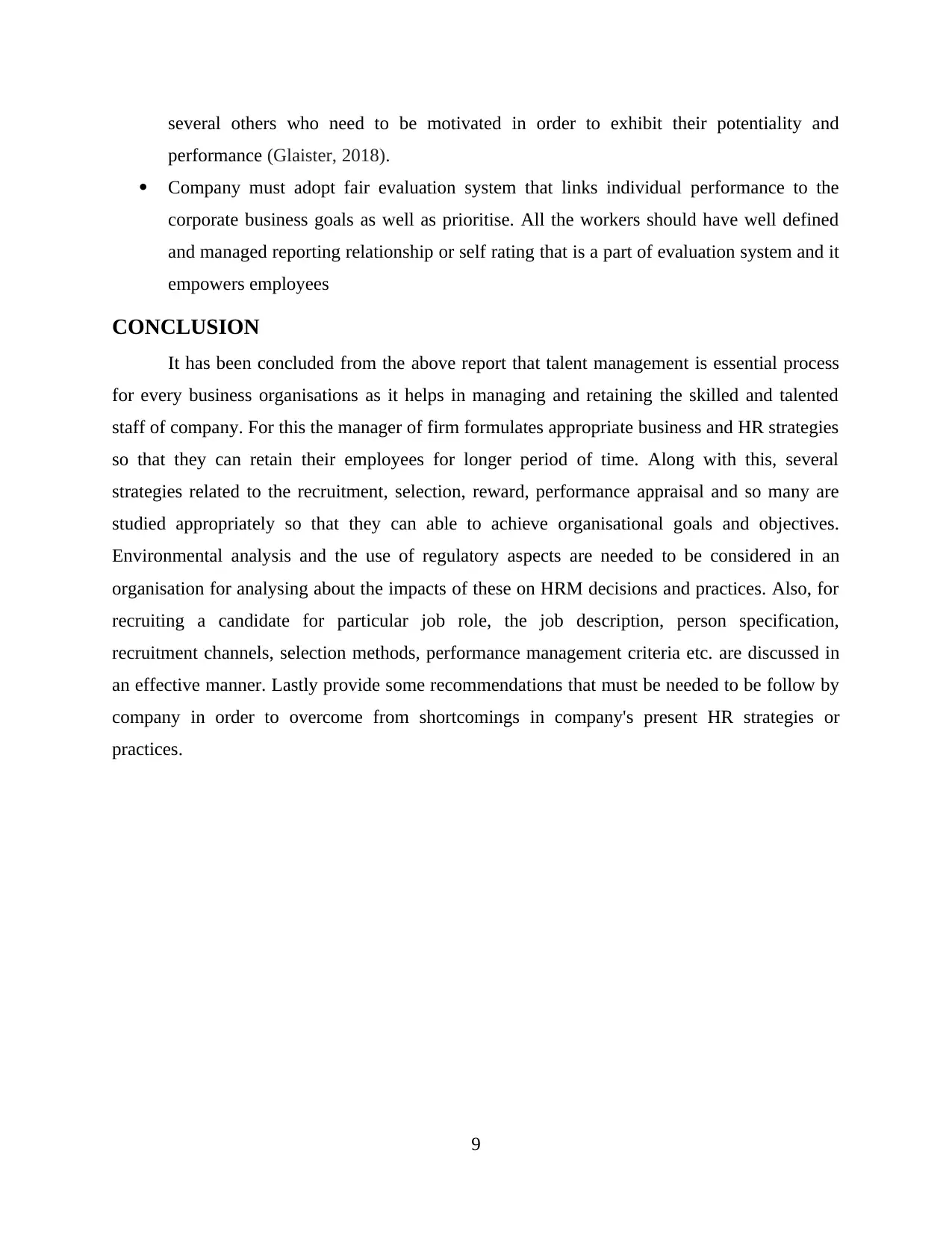
several others who need to be motivated in order to exhibit their potentiality and
performance (Glaister, 2018).
Company must adopt fair evaluation system that links individual performance to the
corporate business goals as well as prioritise. All the workers should have well defined
and managed reporting relationship or self rating that is a part of evaluation system and it
empowers employees
CONCLUSION
It has been concluded from the above report that talent management is essential process
for every business organisations as it helps in managing and retaining the skilled and talented
staff of company. For this the manager of firm formulates appropriate business and HR strategies
so that they can retain their employees for longer period of time. Along with this, several
strategies related to the recruitment, selection, reward, performance appraisal and so many are
studied appropriately so that they can able to achieve organisational goals and objectives.
Environmental analysis and the use of regulatory aspects are needed to be considered in an
organisation for analysing about the impacts of these on HRM decisions and practices. Also, for
recruiting a candidate for particular job role, the job description, person specification,
recruitment channels, selection methods, performance management criteria etc. are discussed in
an effective manner. Lastly provide some recommendations that must be needed to be follow by
company in order to overcome from shortcomings in company's present HR strategies or
practices.
9
performance (Glaister, 2018).
Company must adopt fair evaluation system that links individual performance to the
corporate business goals as well as prioritise. All the workers should have well defined
and managed reporting relationship or self rating that is a part of evaluation system and it
empowers employees
CONCLUSION
It has been concluded from the above report that talent management is essential process
for every business organisations as it helps in managing and retaining the skilled and talented
staff of company. For this the manager of firm formulates appropriate business and HR strategies
so that they can retain their employees for longer period of time. Along with this, several
strategies related to the recruitment, selection, reward, performance appraisal and so many are
studied appropriately so that they can able to achieve organisational goals and objectives.
Environmental analysis and the use of regulatory aspects are needed to be considered in an
organisation for analysing about the impacts of these on HRM decisions and practices. Also, for
recruiting a candidate for particular job role, the job description, person specification,
recruitment channels, selection methods, performance management criteria etc. are discussed in
an effective manner. Lastly provide some recommendations that must be needed to be follow by
company in order to overcome from shortcomings in company's present HR strategies or
practices.
9

REFERENCES
Books & Journals
Cappelli, P. and Keller, J.R., 2017. The historical context of talent management. The Oxford
handbook of talent management. pp.23-42.
Collings, D.G., Mellahi, K. and Cascio, W.F. Eds., 2017. The Oxford handbook of talent
management. Oxford University Press.
Collings, D.G., Scullion, H. and Caligiuri, P.M., 2018. Global talent management. Routledge.
Davis, T. and et. al., 2016. Talent assessment: A new strategy for talent management. Routledge.
Elegbe, J.A., 2016. Talent management in the developing world: Adopting a global perspective.
Routledge.
Glaister, A.J. And et. al., 2018. HRM and performance—The role of talent management as a
transmission mechanism in an emerging market context. Human Resource Management
Journal. 28(1). pp.148-166.
Khoreva, V., Vaiman, V. and Van Zalk, M., 2017. Talent management practice effectiveness:
investigating employee perspective. Employee Relations.
Krishnan, T.N. and Scullion, H., 2017. Talent management and dynamic view of talent in small
and medium enterprises. Human Resource Management Review. 27(3). pp.431-441.
McCracken, M., Currie, D. and Harrison, J., 2016. Understanding graduate recruitment,
development and retention for the enhancement of talent management: sharpening ‘the
edge’of graduate talent. The International Journal of Human Resource Management.
27(22). pp.2727-2752.
McDonnell, A. and et. al., 2017. Talent management: a systematic review and future prospects.
European Journal of International Managemient. 11(1). pp.86-128.
Pandita, D. and Ray, S., 2018. Talent management and employee engagement–a meta-analysis of
their impact on talent retention. Industrial and Commercial Training.
Story, J., Castanheira, F. and Hartig, S., 2016. Corporate social responsibility and organizational
attractiveness: implications for talent management. Social Responsibility Journal.
Tafti, M. M., Mahmoudsalehi, M. and Amiri, M., 2017. Critical success factors, challenges and
obstacles in talent management. Industrial and Commercial Training.
Tatoglu, E., Glaister, A. J. and Demirbag, M., 2016. Talent management motives and practices in
an emerging market: A comparison between MNEs and local firms. Journal of World
Business. 51(2). pp.278-293.
Taylor, S., 2018. Resourcing and talent management. Kogan Page Publishers.
Wang, H. and Liu, Y. eds., 2016. Entrepreneurship and talent management from a global
perspective: Global returnees. Edward Elgar Publishing.
Online
Impact of External Factors on HR Practices. 2015. [Online] Available through:
<http://financewiki.blogspot.com/2015/02/impact-of-external-factors-on-hr.html>.
What diversity means and why it matters. 2018. [Online] Available through:
<https://joinus.barclays/eme/diversity-and-inclusion/>.
10
Books & Journals
Cappelli, P. and Keller, J.R., 2017. The historical context of talent management. The Oxford
handbook of talent management. pp.23-42.
Collings, D.G., Mellahi, K. and Cascio, W.F. Eds., 2017. The Oxford handbook of talent
management. Oxford University Press.
Collings, D.G., Scullion, H. and Caligiuri, P.M., 2018. Global talent management. Routledge.
Davis, T. and et. al., 2016. Talent assessment: A new strategy for talent management. Routledge.
Elegbe, J.A., 2016. Talent management in the developing world: Adopting a global perspective.
Routledge.
Glaister, A.J. And et. al., 2018. HRM and performance—The role of talent management as a
transmission mechanism in an emerging market context. Human Resource Management
Journal. 28(1). pp.148-166.
Khoreva, V., Vaiman, V. and Van Zalk, M., 2017. Talent management practice effectiveness:
investigating employee perspective. Employee Relations.
Krishnan, T.N. and Scullion, H., 2017. Talent management and dynamic view of talent in small
and medium enterprises. Human Resource Management Review. 27(3). pp.431-441.
McCracken, M., Currie, D. and Harrison, J., 2016. Understanding graduate recruitment,
development and retention for the enhancement of talent management: sharpening ‘the
edge’of graduate talent. The International Journal of Human Resource Management.
27(22). pp.2727-2752.
McDonnell, A. and et. al., 2017. Talent management: a systematic review and future prospects.
European Journal of International Managemient. 11(1). pp.86-128.
Pandita, D. and Ray, S., 2018. Talent management and employee engagement–a meta-analysis of
their impact on talent retention. Industrial and Commercial Training.
Story, J., Castanheira, F. and Hartig, S., 2016. Corporate social responsibility and organizational
attractiveness: implications for talent management. Social Responsibility Journal.
Tafti, M. M., Mahmoudsalehi, M. and Amiri, M., 2017. Critical success factors, challenges and
obstacles in talent management. Industrial and Commercial Training.
Tatoglu, E., Glaister, A. J. and Demirbag, M., 2016. Talent management motives and practices in
an emerging market: A comparison between MNEs and local firms. Journal of World
Business. 51(2). pp.278-293.
Taylor, S., 2018. Resourcing and talent management. Kogan Page Publishers.
Wang, H. and Liu, Y. eds., 2016. Entrepreneurship and talent management from a global
perspective: Global returnees. Edward Elgar Publishing.
Online
Impact of External Factors on HR Practices. 2015. [Online] Available through:
<http://financewiki.blogspot.com/2015/02/impact-of-external-factors-on-hr.html>.
What diversity means and why it matters. 2018. [Online] Available through:
<https://joinus.barclays/eme/diversity-and-inclusion/>.
10
⊘ This is a preview!⊘
Do you want full access?
Subscribe today to unlock all pages.

Trusted by 1+ million students worldwide
1 out of 12
Related Documents
Your All-in-One AI-Powered Toolkit for Academic Success.
+13062052269
info@desklib.com
Available 24*7 on WhatsApp / Email
![[object Object]](/_next/static/media/star-bottom.7253800d.svg)
Unlock your academic potential
Copyright © 2020–2025 A2Z Services. All Rights Reserved. Developed and managed by ZUCOL.





